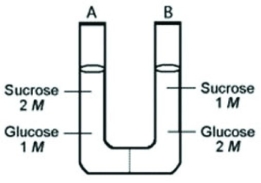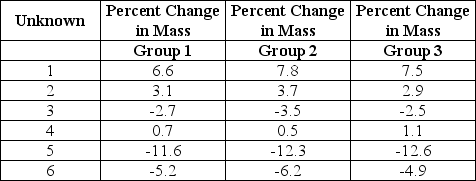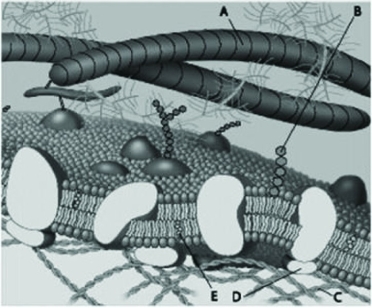A) transmembrane proteins
B) integral membrane proteins
C) peripheral membrane proteins
D) cholesterol
F) A) and B)
Correct Answer

verified
Correct Answer
verified
Multiple Choice
Which of the following types of molecules will diffuse through a cell membrane most readily?
A) large hydrophobic molecules
B) small hydrophobic molecules
C) large polar molecules
D) small ionic molecules
F) All of the above
Correct Answer

verified
Correct Answer
verified
Multiple Choice
The solutions in the two arms of a U-tube are separated by a membrane that is permeable to water and glucose but not to sucrose. Side A is half-filled with a solution of 2 M sucrose and 1 M glucose. Side B is half-filled with 1 M sucrose and 2 M glucose. Initially, the liquid levels on both sides are equal.  When the system illustrated above reaches equilibrium, the sugar concentrations on both sides of the U-tube will be ________.
When the system illustrated above reaches equilibrium, the sugar concentrations on both sides of the U-tube will be ________.
A) 2 M sucrose, 1 M glucose
B) 1 M sucrose, 2 M glucose
C) 1 M sucrose, 1 M glucose
D) 1.5 M sucrose, 1.5 M glucose
F) A) and B)
Correct Answer

verified
Correct Answer
verified
Multiple Choice
In which of the following circumstances would the cell or organism have the greatest need for osmoregulation?
A) an animal connective tissue cell bathed in isotonic body fluid
B) a salmon moving from a river into an ocean
C) a red blood cell surrounded by plasma
D) a plant being grown hydroponically in a watery mixture of designated nutrients
F) B) and C)
Correct Answer

verified
Correct Answer
verified
Multiple Choice
What will happen to a red blood cell (RBC) , which has an internal ion content of about 0.9%, if it is placed into a beaker of pure water?
A) The cell will shrink because the water in the beaker is hypotonic relative to the cytoplasm of the RBC.
B) The cell will shrink because the water in the beaker is hypertonic relative to the cytoplasm of the RBC.
C) The cell will swell because the water in the beaker is hypotonic relative to the cytoplasm of the RBC.
D) The cell will remain the same size because the solution outside the cell is isotonic.
F) None of the above
Correct Answer

verified
Correct Answer
verified
Multiple Choice
Which of the following statements best describes some aspect of the function of a protein that cotransports glucose and sodium ions into the intestinal cells of an animal?
A) Sodium and glucose compete for the same binding site in the cotransporter.
B) Glucose entering the cell down its concentration gradient provides energy for uptake of sodium ions against the electrochemical gradient.
C) Sodium ions can move down their electrochemical gradient through the cotransporter whether or not glucose is present outside the cell.
D) A substance that blocks sodium ions from binding to the cotransport protein will also block the transport of glucose.
F) A) and D)
Correct Answer

verified
Correct Answer
verified
Multiple Choice
Which of the following results is most likely when a plant cell is submerged in a hypertonic solution?
A) The cell will burst.
B) Plasmolysis will shrink the interior of the cell.
C) The cell will become flaccid.
D) The cell will become turgid.
F) All of the above
Correct Answer

verified
Correct Answer
verified
Multiple Choice
Which of the following molecules would decrease the electrochemical gradient across a membrane?
A) an aquaporin
B) a proton pump
C) a potassium channel
D) a sucrose carrier protein
F) None of the above
Correct Answer

verified
Correct Answer
verified
Multiple Choice
In which of the following ways do the membranes of a eukaryotic cell vary?
A) Phospholipids are found only in certain membranes.
B) Certain proteins are unique to each membrane.
C) Only certain membranes of the cell are selectively permeable.
D) Some membranes have hydrophobic surfaces exposed to the cytoplasm while others have hydrophilic surfaces facing the cytoplasm.
F) A) and C)
Correct Answer

verified
Correct Answer
verified
Multiple Choice
Which of the following statements best describes the structure of a membrane based on the fluid mosaic model?
A) The membrane is composed of a fluid bilayer of phospholipids between two layers of hydrophilic proteins.
B) The membrane is composed of a single layer of fluid phospholipids between two layers of hydrophilic proteins.
C) The membrane is composed of a mosaic of fluid polysaccharides and amphipathic proteins.
D) The membrane is composed of a fluid bilayer of phospholipids with embedded amphipathic proteins.
F) All of the above
Correct Answer

verified
Correct Answer
verified
Multiple Choice
Which of the following membrane activities requires energy from ATP hydrolysis?
A) facilitated diffusion of chloride ions across the membrane through a chloride channel
B) movement of Na+ ions from a lower concentration in a mammalian cell to a higher concentration in the extracellular fluid
C) movement of glucose molecules into a bacterial cell from a medium containing a higher concentration of glucose than inside the cell
D) movement of carbon dioxide out of a paramecium
F) C) and D)
Correct Answer

verified
Correct Answer
verified
Multiple Choice
Three lab groups carried out an experiment to identify the concentration of sucrose in six solutions. Each unknown solution (1-6) contained one of the following sucrose concentrations: 0.0 M, 0.2 M, 0.4 M, 0.6 M, 0.8 M, and -1.0 M. Cubes of sweet potato (1 cm3) were soaked for 24 hours in each solution and weighed to determine the change in mass. Each data entry represents the average of three sample replicates expressed as percent change in mass following a 24-hour soak in the unknown solutions. From the data given, which statement below most accurately describes something that has occurred in response to a particular unknown solution?

A) Unknown solution 5 contains the highest concentration of sucrose, and the change in mass is due to the active transport of sucrose out of the cell.
B) Osmosis of water molecules from unknown solution 2 likely caused the increase in mass observed.
C) Passive transport of sucrose out of the potato cells explains the change in mass observed for unknown solution 6.
D) Unknown solution 3 represents a sucrose concentration slightly higher than the molarity of sweet potato cells, thus water is transported out of the cells.
F) None of the above
Correct Answer

verified
Correct Answer
verified
Multiple Choice
Diffusion of ions across membranes through specific ion channels is driven by ________.
A) active transport pumps
B) ion concentration gradients only
C) electrical gradients only
D) ion electrochemical gradients
F) B) and C)
Correct Answer

verified
Correct Answer
verified
Multiple Choice
Cell membranes have distinct inside and outside faces. Which of the following statements is the most plausible explanation for the asymmetrical nature of the two layers of the membrane?
A) Cell membranes form a border between adjacent cells in tightly packed tissues such as epithelium.
B) Cell membranes communicate signals between different cell types.
C) The two layers of a cell membrane face different environments and carry out different functions.
D) Proteins only function on the cytoplasmic side of the cell membrane.
F) A) and C)
Correct Answer

verified
Correct Answer
verified
Multiple Choice
Which of the following statements best explains the reason that lipids and proteins are free to move laterally in membranes?
A) The interior of the membrane is filled with liquid water.
B) Lipids and proteins repulse each other in the membrane.
C) Hydrophilic portions of the lipids are in the interior of the membrane.
D) There are only weak hydrophobic interactions in the interior of the membrane.
F) A) and C)
Correct Answer

verified
Correct Answer
verified
Multiple Choice
 Which component in the accompanying figure plays a critical role in cell-cell recognition?
Which component in the accompanying figure plays a critical role in cell-cell recognition?
A) A
B) B
C) C
D) E
F) B) and D)
Correct Answer

verified
Correct Answer
verified
Multiple Choice
Which of the following statements best describes the difference between pinocytosis and receptor-mediated endocytosis?
A) pinocytosis brings only water molecules into the cell, but receptor-mediated endocytosis brings in other molecules as well
B) pinocytosis increases the surface area of the plasma membrane, whereas receptor-mediated endocytosis decreases the plasma membrane surface area
C) pinocytosis is nonselective in the molecules it brings into the cell, whereas receptor-mediated endocytosis offers more selectivity
D) pinocytosis can concentrate substances from the extracellular fluid, but receptor-mediated endocytosis cannot
F) C) and D)
Correct Answer

verified
Correct Answer
verified
Multiple Choice
Several epidemic microbial diseases of earlier centuries incurred high death rates because they resulted in severe dehydration due to diarrhea. Today these diseases are usually not fatal because of the development of which of the following types of treatments?
A) antiviral medications that are efficient and work well with most viruses
B) intravenous feeding techniques
C) medications to slow blood loss
D) hydrating drinks with high concentrations of salt and glucose
F) A) and C)
Correct Answer

verified
Correct Answer
verified
Multiple Choice
In receptor-mediated endocytosis, membrane receptors bind to molecules outside of the cell. Immediately following endocytosis where will the membrane receptors be located?
A) on the outside of vesicles
B) on the inside surface of the cell membrane
C) on the inside surface of the vesicle
D) on the outer surface of the nucleus
F) A) and D)
Correct Answer

verified
Correct Answer
verified
Multiple Choice
Which of the following statements best explains why the sodium-potassium pump is an electrogenic pump?
A) It transports equal quantities of Na+ and K+ across the membrane in opposite directions.
B) It is used to drive the transport of glucose against a concentration gradient.
C) It decreases the voltage difference across the membrane.
D) It generates voltage across the membrane.
F) B) and D)
Correct Answer

verified
Correct Answer
verified
Showing 21 - 40 of 67
Related Exams